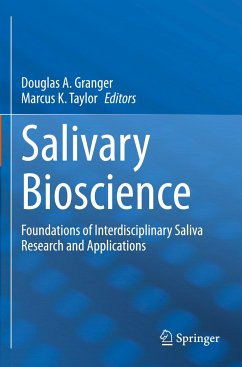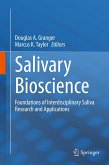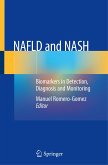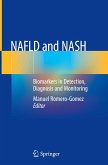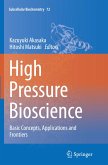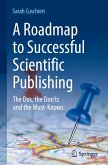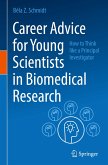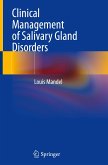Salivary Bioscience
Foundations of Interdisciplinary Saliva Research and Applications
Herausgegeben:Granger, Douglas A.; Taylor, Marcus K.
Salivary Bioscience
Foundations of Interdisciplinary Saliva Research and Applications
Herausgegeben:Granger, Douglas A.; Taylor, Marcus K.
- Broschiertes Buch
- Merkliste
- Auf die Merkliste
- Bewerten Bewerten
- Teilen
- Produkt teilen
- Produkterinnerung
- Produkterinnerung
This book provides the first comprehensive overview of the emerging field of interdisciplinary salivary bioscience. It serves as a foundational reference guide to the collection, analysis, and interpretation of salivary data, as well as its myriad applications in medicine, surveillance and public health. The ease and non-invasive nature of saliva collection makes it highly useful in diverse fields such as pediatrics, dentistry, neuroscience, psychology, animal welfare and precision medicine. This book introduces students and scientists alike to the vast potential of salivary bioscience in both research and practice.…mehr
Andere Kunden interessierten sich auch für
![Salivary Bioscience Salivary Bioscience]() Salivary Bioscience135,99 €
Salivary Bioscience135,99 €![NAFLD and NASH NAFLD and NASH]() NAFLD and NASH90,94 €
NAFLD and NASH90,94 €![NAFLD and NASH NAFLD and NASH]() NAFLD and NASH90,99 €
NAFLD and NASH90,99 €![High Pressure Bioscience High Pressure Bioscience]() High Pressure Bioscience150,99 €
High Pressure Bioscience150,99 €![A Roadmap to Successful Scientific Publishing A Roadmap to Successful Scientific Publishing]() Sarah CuschieriA Roadmap to Successful Scientific Publishing40,65 €
Sarah CuschieriA Roadmap to Successful Scientific Publishing40,65 €![Career Advice for Young Scientists in Biomedical Research Career Advice for Young Scientists in Biomedical Research]() Béla Z. SchmidtCareer Advice for Young Scientists in Biomedical Research30,99 €
Béla Z. SchmidtCareer Advice for Young Scientists in Biomedical Research30,99 €![Clinical Management of Salivary Gland Disorders Clinical Management of Salivary Gland Disorders]() Louis MandelClinical Management of Salivary Gland Disorders97,99 €
Louis MandelClinical Management of Salivary Gland Disorders97,99 €-
-
-
This book provides the first comprehensive overview of the emerging field of interdisciplinary salivary bioscience. It serves as a foundational reference guide to the collection, analysis, and interpretation of salivary data, as well as its myriad applications in medicine, surveillance and public health. The ease and non-invasive nature of saliva collection makes it highly useful in diverse fields such as pediatrics, dentistry, neuroscience, psychology, animal welfare and precision medicine. This book introduces students and scientists alike to the vast potential of salivary bioscience in both research and practice.
Produktdetails
- Produktdetails
- Verlag: Springer / Springer International Publishing / Springer, Berlin
- Artikelnr. des Verlages: 978-3-030-35786-3
- 1st edition 2020
- Seitenzahl: 768
- Erscheinungstermin: 8. April 2021
- Englisch
- Abmessung: 235mm x 155mm x 41mm
- Gewicht: 1142g
- ISBN-13: 9783030357863
- ISBN-10: 3030357864
- Artikelnr.: 61379658
- Herstellerkennzeichnung Die Herstellerinformationen sind derzeit nicht verfügbar.
- Verlag: Springer / Springer International Publishing / Springer, Berlin
- Artikelnr. des Verlages: 978-3-030-35786-3
- 1st edition 2020
- Seitenzahl: 768
- Erscheinungstermin: 8. April 2021
- Englisch
- Abmessung: 235mm x 155mm x 41mm
- Gewicht: 1142g
- ISBN-13: 9783030357863
- ISBN-10: 3030357864
- Artikelnr.: 61379658
- Herstellerkennzeichnung Die Herstellerinformationen sind derzeit nicht verfügbar.
Douglas A. Granger, Ph.D., is engaged in multi-institution research focused on the discovery, measurement, and application of analytes (e.g., enzymes, hormones, antibodies, chemicals, elements, cytokines) in saliva. He is a Chancellor's Professor at UC Irvine,and holds adjunct faculty positions at Johns Hopkins University and University of Nebraska. His studies have been instrumental in the conceptualization and analysis of biosocial relationships involving child well-being, parent-child and family relationships, as well as how these biosocial links moderate and mediate the effects of adversity and stress on health and development. Marcus K. Taylor, Ph.D., is a Faculty Affiliate at UC Irvine and a Fellow of the American College of Sports Medicine. He previously held faculty positions at Duke University and San Diego State University. His program of research focuses on stress physiology in extreme environments, blast exposure, and gene-environment interactions. His recent work appears in Journal of Special Operations Medicine, Psychoneuroendocrinology, and Psychiatry Research.
Part 1: What is Salivary Bioscience, Why is it Important, and How Do We Study It?.- Chapter 1: Foundations of Interdisciplinary Salivary Bioscience: An Introduction (Granger et al.).- Chapter 2: Salivary Gland Anatomy and Physiology (Hernández et al.).- Chapter 3: Saliva Collection, Handing, Transport, and Storage: Special Considerations and Best Practices for Interdisciplinary Salivary Bioscience(Padilla et al.).- Chapter 4: Analytical Strategies and Tactics in Salivary Bioscience (Riis et al.).- Part 2: Physiology and Development Research and Applications (Part 2 Editor: Dr. Jenna Riis).- Chapter 5: Salivary Bioscience, Human Stress, and the Hypothalamic Pituitary Adrenal Axis (Clow et al.).- Chapter 6: The Use of Saliva for Genetics and Epigenetics Research (Nemoda et al.).- Chapter 7: Saliva as a Window Into the Human Oral Microbiome and Metabolome(Whiteson et al.).- Chapter 8: Salivaomics, saliva Exo-somics, and Saliva Liquid Biopsy (Wong et al.).- Chapter 9: Salivary Bioscience, Immunity, and Inflammation (Riis et al.).- Chapter 10:Salivary Bioscience and Human Development (Hibel et al.).- Part 3: Biomedical Research and Related Applications (Part 3 Editor: Dr. Elizabeth Thomas).- Chapter 11: Biomedical Research and Related Applications:Current Assay Methods and Quality Requirements in Oral Fluid Diagnostics Applications (Granger S. et al.).- Chapter 12: Salivary Biomarkers and Neurodegenerative Conditions (Thomas et al.).- Chapter 13: The Use of Antibodies in Saliva to Measure PathogenExposure and Infection(Heaney et al.).- Chapter 14: Salivary Bioscience and Pain (Payne et al.).- Chapter 15: Salivary Bioscience and Environmental Exposure Assessment (Panuwet et al.).- Chapter 16: Saliva and Drugs of Abuse (Navazesh et al.).- Chapter 17: Therapeutic Drug Monitoring in Saliva (Thomas).- Chapter 18: Salivary Bioscience and Periodontal Medicine (Freire et al.).- Chapter 19: Salivary Bioscience and Cancer (Navazesh et al.).- Part 4: Psychosocial Research and Applications(Part 4 Editor: Dr. Kate Ryan Kuhlman).- Chapter 20: Salivary Bioscience in Clinical Psychologyand Psychiatry(Kuhlman).- Chapter 21: Salivary Bioscience Research in Health Psychology and Behavioral Medicine (Hoyt et al.).- chapter 22: The Neuroscience of Human Social Behavior: A Review of How Testosterone and Cortisol Underpin Competition and Affiliation Dynamics (Kornienko et al.).- chapter 23: Salivary Studies of the Social Neuroscience of Human-animal Interaction (Pendry et al.).- Part 5: Population Health Research and Applications(Part 5 Editor: Dr. Marcus Taylor).- Chapter 24: Salivary Bioscience and Military, Space, and OperationalResearch(Roma et al.).- Chapter 25: Salivary Bioscience Research Related to Prenatal Adversity (Eiden et al.).- Chapter 26: Salivary Bioscience and Pediatrics (Johnson et al.).- Chapter 27: Use of saliva to better understand the experience of adulthood and aging(Almeida et al.).- Chapter 28: Salivary Bioscience and Research on Animal Welfare and Conservation Science(Staley et al.).- Part 6: The Way Forward: Future Directions for the Science and Practice of Salivary Bioscience.- Chapter 29:Applications of Salivary Bioscience to Precision Medicine (Kuhlman).- Chapter 30:Public Health and IndustryApplications of Salivary Bioscience (Riis et al.).- Chapter 31: Envisioning the Future of Interdisciplinary Salivary Bioscience (Granger et al.).
Part 1: What is Salivary Bioscience, Why is it Important, and How Do We Study It?.- Chapter 1: Foundations of Interdisciplinary Salivary Bioscience: An Introduction (Granger et al.).- Chapter 2: Salivary Gland Anatomy and Physiology (Hernández et al.).- Chapter 3: Saliva Collection, Handing, Transport, and Storage: Special Considerations and Best Practices for Interdisciplinary Salivary Bioscience(Padilla et al.).- Chapter 4: Analytical Strategies and Tactics in Salivary Bioscience (Riis et al.).- Part 2: Physiology and Development Research and Applications (Part 2 Editor: Dr. Jenna Riis).- Chapter 5: Salivary Bioscience, Human Stress, and the Hypothalamic Pituitary Adrenal Axis (Clow et al.).- Chapter 6: The Use of Saliva for Genetics and Epigenetics Research (Nemoda et al.).- Chapter 7: Saliva as a Window Into the Human Oral Microbiome and Metabolome(Whiteson et al.).- Chapter 8: Salivaomics, saliva Exo-somics, and Saliva Liquid Biopsy (Wong et al.).- Chapter 9: Salivary Bioscience, Immunity, and Inflammation (Riis et al.).- Chapter 10:Salivary Bioscience and Human Development (Hibel et al.).- Part 3: Biomedical Research and Related Applications (Part 3 Editor: Dr. Elizabeth Thomas).- Chapter 11: Biomedical Research and Related Applications:Current Assay Methods and Quality Requirements in Oral Fluid Diagnostics Applications (Granger S. et al.).- Chapter 12: Salivary Biomarkers and Neurodegenerative Conditions (Thomas et al.).- Chapter 13: The Use of Antibodies in Saliva to Measure PathogenExposure and Infection(Heaney et al.).- Chapter 14: Salivary Bioscience and Pain (Payne et al.).- Chapter 15: Salivary Bioscience and Environmental Exposure Assessment (Panuwet et al.).- Chapter 16: Saliva and Drugs of Abuse (Navazesh et al.).- Chapter 17: Therapeutic Drug Monitoring in Saliva (Thomas).- Chapter 18: Salivary Bioscience and Periodontal Medicine (Freire et al.).- Chapter 19: Salivary Bioscience and Cancer (Navazesh et al.).- Part 4: Psychosocial Research and Applications(Part 4 Editor: Dr. Kate Ryan Kuhlman).- Chapter 20: Salivary Bioscience in Clinical Psychologyand Psychiatry(Kuhlman).- Chapter 21: Salivary Bioscience Research in Health Psychology and Behavioral Medicine (Hoyt et al.).- chapter 22: The Neuroscience of Human Social Behavior: A Review of How Testosterone and Cortisol Underpin Competition and Affiliation Dynamics (Kornienko et al.).- chapter 23: Salivary Studies of the Social Neuroscience of Human-animal Interaction (Pendry et al.).- Part 5: Population Health Research and Applications(Part 5 Editor: Dr. Marcus Taylor).- Chapter 24: Salivary Bioscience and Military, Space, and OperationalResearch(Roma et al.).- Chapter 25: Salivary Bioscience Research Related to Prenatal Adversity (Eiden et al.).- Chapter 26: Salivary Bioscience and Pediatrics (Johnson et al.).- Chapter 27: Use of saliva to better understand the experience of adulthood and aging(Almeida et al.).- Chapter 28: Salivary Bioscience and Research on Animal Welfare and Conservation Science(Staley et al.).- Part 6: The Way Forward: Future Directions for the Science and Practice of Salivary Bioscience.- Chapter 29:Applications of Salivary Bioscience to Precision Medicine (Kuhlman).- Chapter 30:Public Health and IndustryApplications of Salivary Bioscience (Riis et al.).- Chapter 31: Envisioning the Future of Interdisciplinary Salivary Bioscience (Granger et al.).

